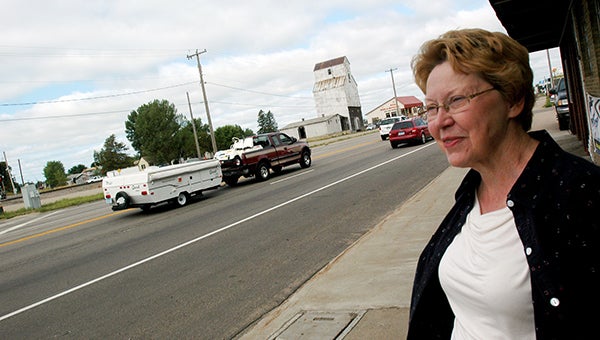Paying for green energy an obstacle for cities
Published 11:04 am Thursday, September 12, 2013

Royalton Mayor Andrea Lauer looks at oncoming traffic traveling north for the Labor Day weekend. US Hwy 10 intersects the town of Royalton, sending thousands of vacationers through her town. She works with a consortium of neighboring towns and townships in thinking of ways to capture some of that tourism for Royalton. –Vickie Kettlewell/MPR
By Jennifer Vogel
Minnesota Public Radio News
The promise of free or cheap power and heat is attractive for small Minnesota cities looking to save money having a lot of open space for solar panels and wind turbines or a lot of wood or agricultural waste to burn.
But the upfront costs for these kinds of projects are substantial, often ranging in the hundreds of thousands or even millions of dollars. This poses a formidable hurdle and is a big reason many projects are never realized.
Up until late last year, federal American Recovery and Reinvestment Act money drove many new-energy projects in Minnesota cities. The state distributed more than $54 million through a competitive grant program between 2009 and 2012, “supporting the Minnesota energy economy as we moved out of the recession,” said a December 2012 report from the Minnesota Department of Commerce.
The federal dollars went to schools all over the state, which installed efficient lighting and new boilers and the like. They went to companies working on innovations like improved battery technology and to local governments dabbling in new-energy generation. Millions more went to weatherize low-income homes and make government buildings more efficient.
Outlays included $27,000 for the solar system on City Hall in Kasson, $100,000 to put the geothermal heating and cooling system in the Lac qui Parle County courthouse and $34,000 for the 7.5-kilowatt solar installation on the roof of City Hall in Royalton.
“We try to keep up,” said Royalton Mayor Andrea Lauer. “If there are ways we can make things energy efficient and still have a positive impact on the city budget, those
are things that have to go hand in hand.” Now, Royalton is considering a small wind project, which Lauer thinks could help draw businesses. “It would create a certain buzz and perhaps get people to say, ‘Can we check out this city more?’”
The stimulus money was a big boost and its absence has left a void. “I do think the lack of the stimulus dollars has been a challenge,” said Melissa Pawlisch, statewide director for a public-private partnership called Clean Energy Resource Teams, or CERTS. The organization offers small design and planning grants for energy projects. But communities have other options, she said. “It’s less about having a grant and more about ways to do financing.”
That might mean including a green-energy project in a capital plan, just like a city would do with a new road or water plant. “That is their strong suit,” said John Farrell of the Institute for Local Self-Reliance, based in Minneapolis and Washington, D.C. “[Local governments] can borrow money over a long period of time for all sorts of capital projects. They can look at bond payments to be offset by energy savings.”
That’s how Crow Wing County built a $1.3 million landfill heat-generating project in 2008. The project was financed out of the county solid waste program operating budget and the return comes from energy savings, but also from the sale of carbon reduction credits. Because the project prevents methane from being released by the landfill into the environment – it’s used to run a boiler system during the winter for building heat and is also “flared” or burned off — the county gets credits for those avoided emissions. It can sell the credits to companies looking to offset their carbon footprints.
“The last time we sold we made $48,000,” said Doug Morris, Crow Wing County solid waste coordinator. “We sell them once a year… The county is trying to do the right thing.”
Pawlisch also recommends an approach known as “performance contracting.” A community estimates how much it will save by building a new-energy project or making its buildings more efficient and then can use the projected savings to finance the project. “You don’t have to use grant dollars, not even your operating budget,” said Pawlisch, who has a grant to educate people about the financing mechanism. “You can translate your lower operating costs into bigger projects.”
There are still federal tax credits too, and other incentives include a Minnesota-made rebate, created in 2010, that applies to equipment manufactured here.
A focus on solar
Ken Bradley with MN Community Solar, which is installing an early solar garden on the roof of a business on East Lake Street in Minneapolis, thinks solar is about to have its day in the sun.
“This week, I talked with municipal governments, more than one,” Bradley said. “We’ve met with congregations in churches that want to do it. We’ve talked with nonprofits.”
The price of solar panels is falling, which Farrell thinks will accelerate adoption by individuals as well as communities. “Solar is on the cusp of really taking off,” Farrell said, predicting that more small-power generation will create tensions with the utilities. “There will be a big fight,” he said. “It’s a threat to their business models. What do you do when your customer has a more cost-effective method than buying from you?”
These sorts of debates over distributed energy generation have cropped up in other parts of the country, as utilities wonder who will pay for the grid as customers fall from the big-power rolls. But Lee Gabler, director of demand-side management and renewable operations for Xcel, was unperturbed by the topic. That may be because his is one of the utilities mandated by state law to buy and provide more solar energy. “By 2020, to meet the 1.5 percent of retail sales through solar energy, this will continue to be a growing piece,” he said, adding a note of caution about the grid.
Interest in solar benefitted Red Wing, where solar installations big enough to generate 217 kilowatts by year’s end – enough for three dozen homes — are being financed by the California-based firm Newport Partners. The $1.8 million solar installation is financially attractive thanks to various federal and state tax credits and rebates — including the Minnesota-made bonus and Solar Rewards — and because Xcel needs solar to meet its production goal.
For the first 6.5 years, Newport will own panels on Red Wing’s municipal buildings. And the city will pay Newport for the solar electricity at a 20 percent discount from what it would have paid Xcel for the same amount of energy. At the end of the 6.5 years, the city will own the panels and get an estimated $40,000 to $45,000 worth of energy every year for free.
The only cost to the city will be the expense of building two carports that will support some of the solar arrays, totaling around $170,000.
The arrays are important to Red Wing for a handful of reasons, said Jay McCleary, deputy director of government services.
“No. 1 is taxpayer dollars,” he said. “Second, the city of Red Wing and its citizens have made it clear they want our community to be very conscientious of how we operate… They want us to reduce our carbon footprint. They want us to be socially active and correct.
“I think we’re all obligated to do our part,” he said. “I don’t care who you are. If you have concerns at all, do something about it.”


